Analysis of Innovation and Sustainable Business Development at Amazon
VerifiedAdded on 2022/12/14
|22
|4059
|306
Report
AI Summary
This report provides a comprehensive analysis of Amazon.com's innovation and sustainable business development. It delves into the company's business overview, highlighting its evolution as a leading online marketplace. The report examines Amazon's innovative strategies, including its organizational structure, business model canvas, and the evolution of its business model. It explores the coopetition-based model, digital strategy triangle, and disruptive innovation approaches that have contributed to Amazon's success. Furthermore, the report investigates how Amazon builds online trust and e-loyalty, addressing psychological factors and the dynamics of online competition. The report concludes with recommendations for Amazon to maintain its competitive edge and ensure long-term sustainability. The appendices provide supporting data and visual representations of key concepts discussed throughout the report.
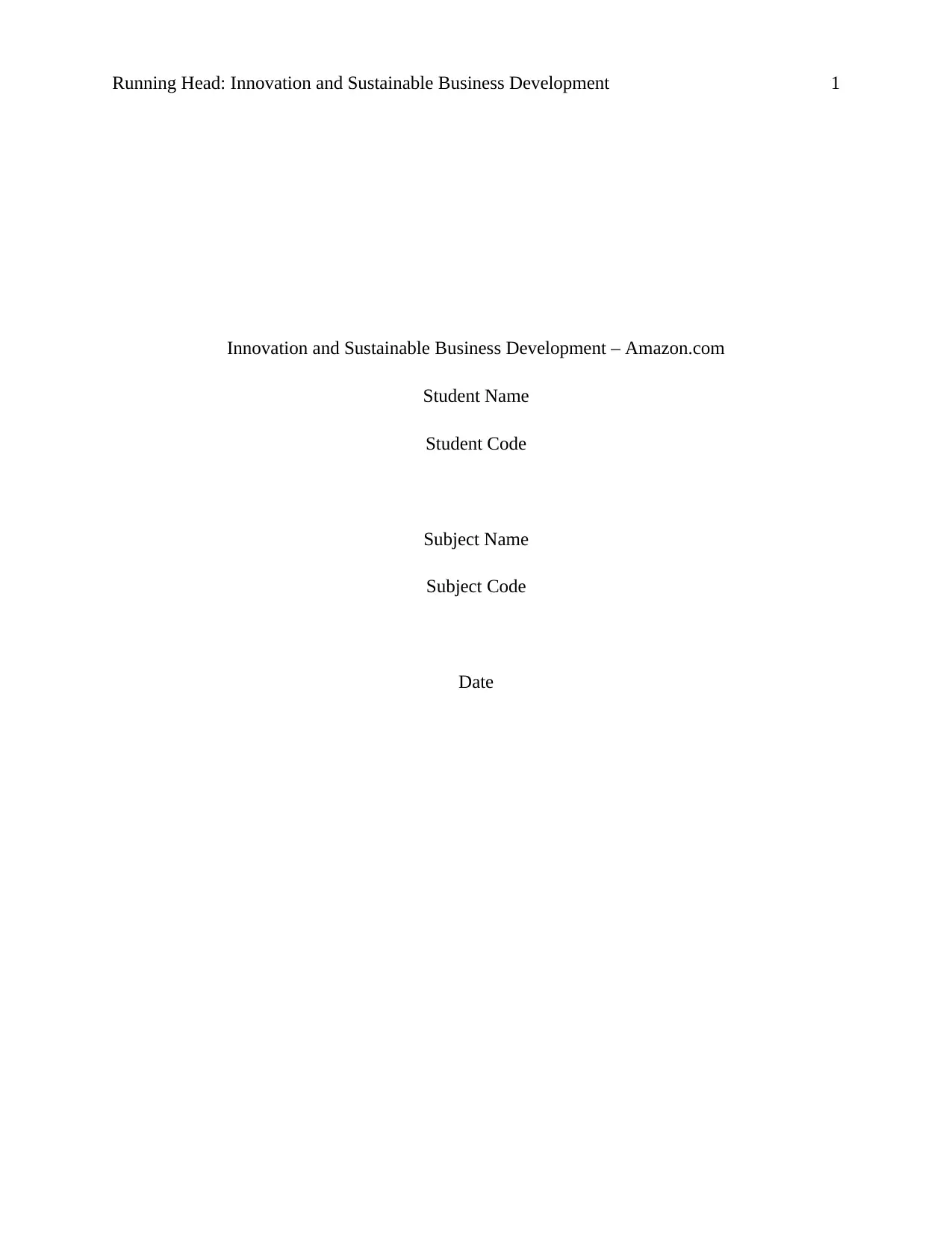
Running Head: Innovation and Sustainable Business Development 1
Innovation and Sustainable Business Development – Amazon.com
Student Name
Student Code
Subject Name
Subject Code
Date
Innovation and Sustainable Business Development – Amazon.com
Student Name
Student Code
Subject Name
Subject Code
Date
Paraphrase This Document
Need a fresh take? Get an instant paraphrase of this document with our AI Paraphraser
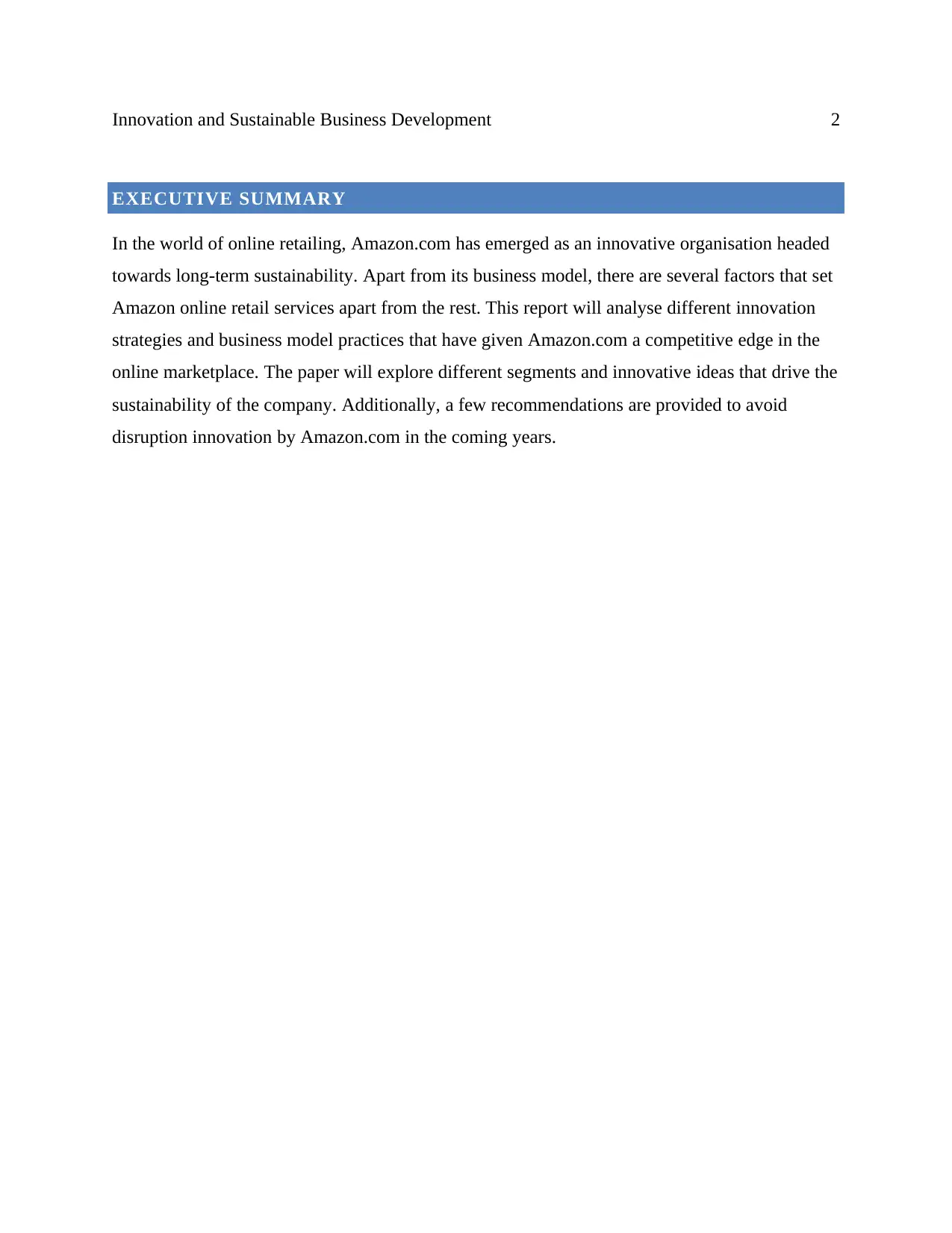
Innovation and Sustainable Business Development 2
EXECUTIVE SUMMARY
In the world of online retailing, Amazon.com has emerged as an innovative organisation headed
towards long-term sustainability. Apart from its business model, there are several factors that set
Amazon online retail services apart from the rest. This report will analyse different innovation
strategies and business model practices that have given Amazon.com a competitive edge in the
online marketplace. The paper will explore different segments and innovative ideas that drive the
sustainability of the company. Additionally, a few recommendations are provided to avoid
disruption innovation by Amazon.com in the coming years.
EXECUTIVE SUMMARY
In the world of online retailing, Amazon.com has emerged as an innovative organisation headed
towards long-term sustainability. Apart from its business model, there are several factors that set
Amazon online retail services apart from the rest. This report will analyse different innovation
strategies and business model practices that have given Amazon.com a competitive edge in the
online marketplace. The paper will explore different segments and innovative ideas that drive the
sustainability of the company. Additionally, a few recommendations are provided to avoid
disruption innovation by Amazon.com in the coming years.
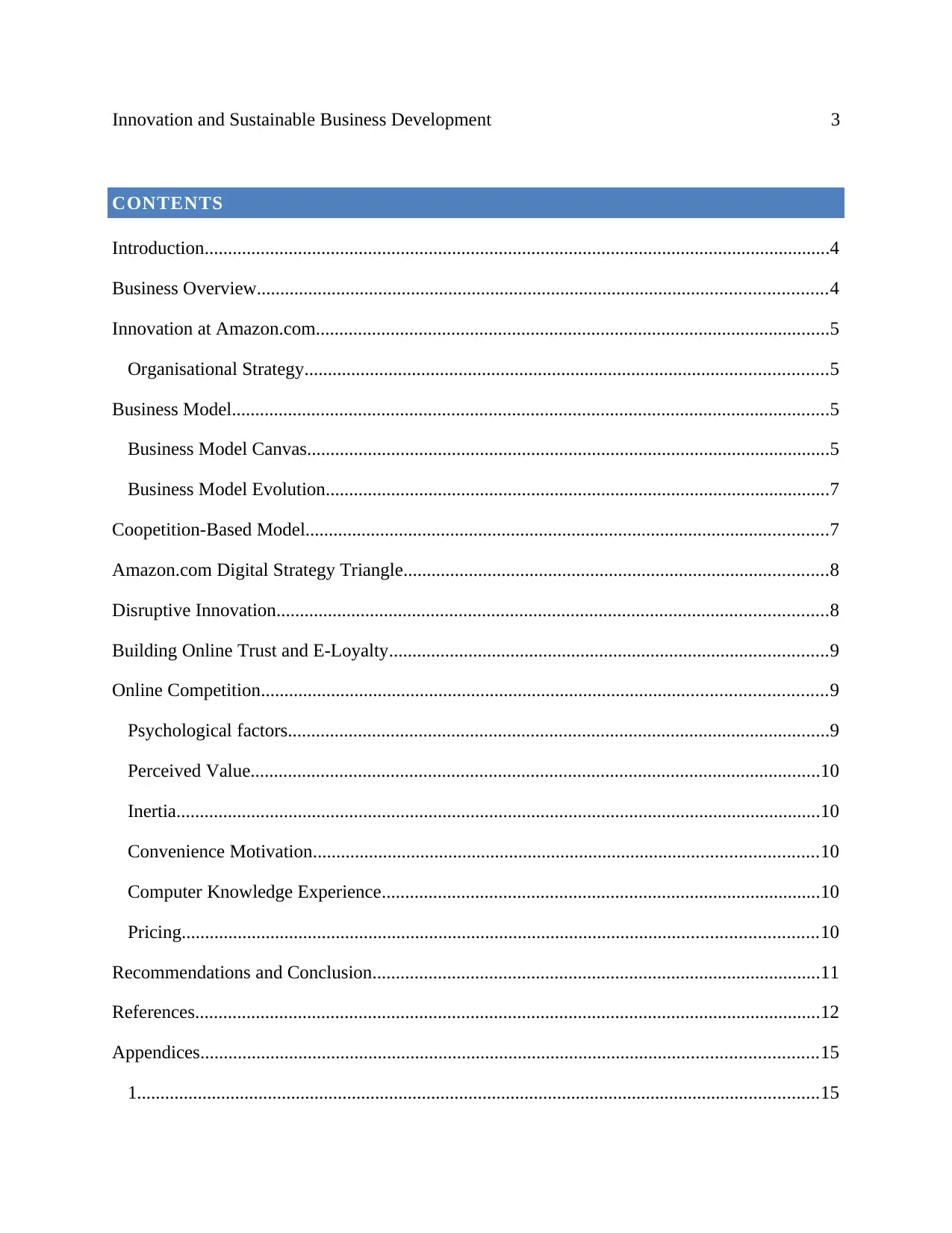
Innovation and Sustainable Business Development 3
CONTENTS
Introduction......................................................................................................................................4
Business Overview..........................................................................................................................4
Innovation at Amazon.com..............................................................................................................5
Organisational Strategy................................................................................................................5
Business Model................................................................................................................................5
Business Model Canvas................................................................................................................5
Business Model Evolution............................................................................................................7
Coopetition-Based Model................................................................................................................7
Amazon.com Digital Strategy Triangle...........................................................................................8
Disruptive Innovation......................................................................................................................8
Building Online Trust and E-Loyalty..............................................................................................9
Online Competition.........................................................................................................................9
Psychological factors....................................................................................................................9
Perceived Value..........................................................................................................................10
Inertia..........................................................................................................................................10
Convenience Motivation............................................................................................................10
Computer Knowledge Experience..............................................................................................10
Pricing........................................................................................................................................10
Recommendations and Conclusion................................................................................................11
References......................................................................................................................................12
Appendices....................................................................................................................................15
1..................................................................................................................................................15
CONTENTS
Introduction......................................................................................................................................4
Business Overview..........................................................................................................................4
Innovation at Amazon.com..............................................................................................................5
Organisational Strategy................................................................................................................5
Business Model................................................................................................................................5
Business Model Canvas................................................................................................................5
Business Model Evolution............................................................................................................7
Coopetition-Based Model................................................................................................................7
Amazon.com Digital Strategy Triangle...........................................................................................8
Disruptive Innovation......................................................................................................................8
Building Online Trust and E-Loyalty..............................................................................................9
Online Competition.........................................................................................................................9
Psychological factors....................................................................................................................9
Perceived Value..........................................................................................................................10
Inertia..........................................................................................................................................10
Convenience Motivation............................................................................................................10
Computer Knowledge Experience..............................................................................................10
Pricing........................................................................................................................................10
Recommendations and Conclusion................................................................................................11
References......................................................................................................................................12
Appendices....................................................................................................................................15
1..................................................................................................................................................15
⊘ This is a preview!⊘
Do you want full access?
Subscribe today to unlock all pages.

Trusted by 1+ million students worldwide

Innovation and Sustainable Business Development 4
B.................................................................................................................................................16
C.................................................................................................................................................17
4..................................................................................................................................................18
5..................................................................................................................................................19
6..................................................................................................................................................20
B.................................................................................................................................................16
C.................................................................................................................................................17
4..................................................................................................................................................18
5..................................................................................................................................................19
6..................................................................................................................................................20
Paraphrase This Document
Need a fresh take? Get an instant paraphrase of this document with our AI Paraphraser
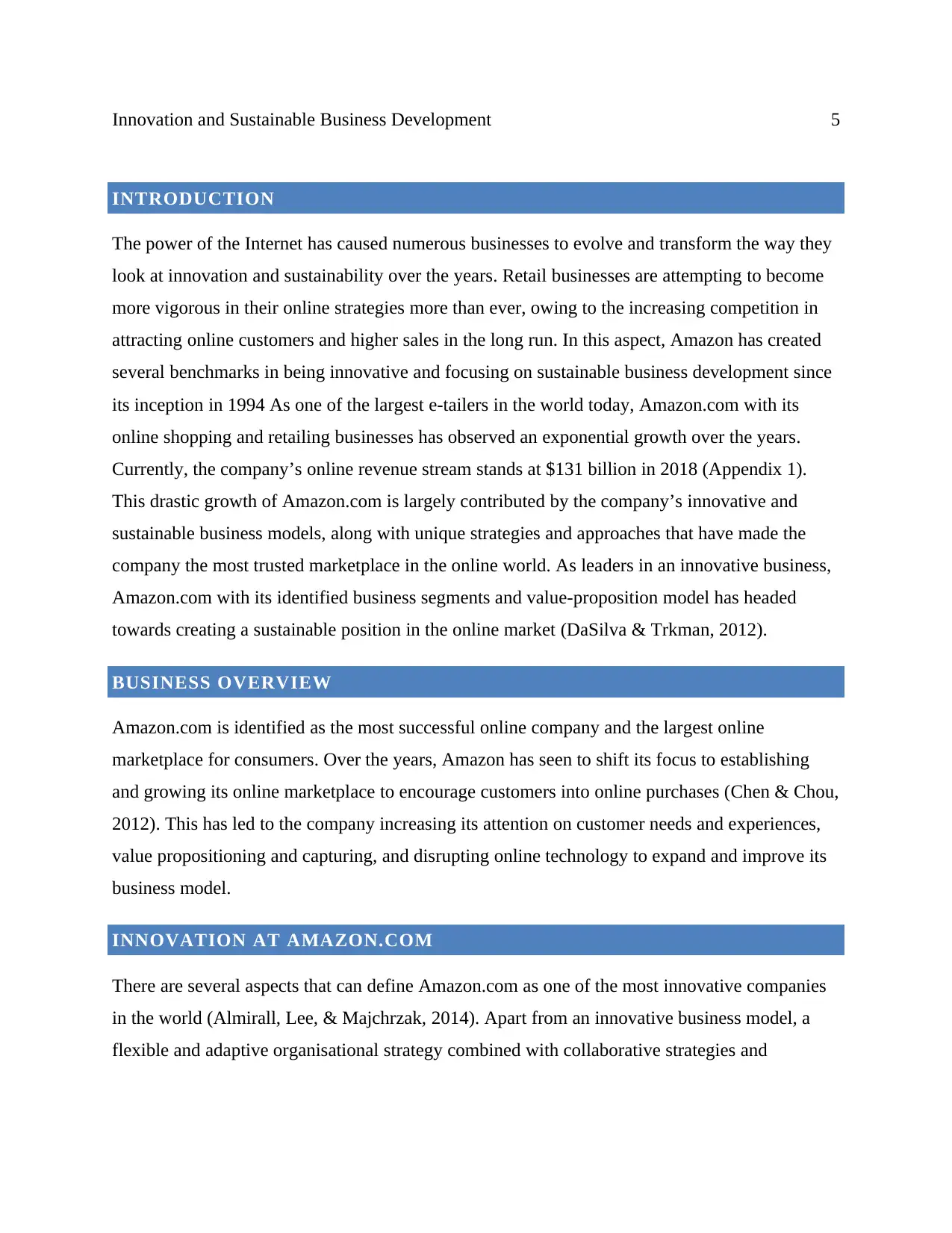
Innovation and Sustainable Business Development 5
INTRODUCTION
The power of the Internet has caused numerous businesses to evolve and transform the way they
look at innovation and sustainability over the years. Retail businesses are attempting to become
more vigorous in their online strategies more than ever, owing to the increasing competition in
attracting online customers and higher sales in the long run. In this aspect, Amazon has created
several benchmarks in being innovative and focusing on sustainable business development since
its inception in 1994 As one of the largest e-tailers in the world today, Amazon.com with its
online shopping and retailing businesses has observed an exponential growth over the years.
Currently, the company’s online revenue stream stands at $131 billion in 2018 (Appendix 1).
This drastic growth of Amazon.com is largely contributed by the company’s innovative and
sustainable business models, along with unique strategies and approaches that have made the
company the most trusted marketplace in the online world. As leaders in an innovative business,
Amazon.com with its identified business segments and value-proposition model has headed
towards creating a sustainable position in the online market (DaSilva & Trkman, 2012).
BUSINESS OVERVIEW
Amazon.com is identified as the most successful online company and the largest online
marketplace for consumers. Over the years, Amazon has seen to shift its focus to establishing
and growing its online marketplace to encourage customers into online purchases (Chen & Chou,
2012). This has led to the company increasing its attention on customer needs and experiences,
value propositioning and capturing, and disrupting online technology to expand and improve its
business model.
INNOVATION AT AMAZON.COM
There are several aspects that can define Amazon.com as one of the most innovative companies
in the world (Almirall, Lee, & Majchrzak, 2014). Apart from an innovative business model, a
flexible and adaptive organisational strategy combined with collaborative strategies and
INTRODUCTION
The power of the Internet has caused numerous businesses to evolve and transform the way they
look at innovation and sustainability over the years. Retail businesses are attempting to become
more vigorous in their online strategies more than ever, owing to the increasing competition in
attracting online customers and higher sales in the long run. In this aspect, Amazon has created
several benchmarks in being innovative and focusing on sustainable business development since
its inception in 1994 As one of the largest e-tailers in the world today, Amazon.com with its
online shopping and retailing businesses has observed an exponential growth over the years.
Currently, the company’s online revenue stream stands at $131 billion in 2018 (Appendix 1).
This drastic growth of Amazon.com is largely contributed by the company’s innovative and
sustainable business models, along with unique strategies and approaches that have made the
company the most trusted marketplace in the online world. As leaders in an innovative business,
Amazon.com with its identified business segments and value-proposition model has headed
towards creating a sustainable position in the online market (DaSilva & Trkman, 2012).
BUSINESS OVERVIEW
Amazon.com is identified as the most successful online company and the largest online
marketplace for consumers. Over the years, Amazon has seen to shift its focus to establishing
and growing its online marketplace to encourage customers into online purchases (Chen & Chou,
2012). This has led to the company increasing its attention on customer needs and experiences,
value propositioning and capturing, and disrupting online technology to expand and improve its
business model.
INNOVATION AT AMAZON.COM
There are several aspects that can define Amazon.com as one of the most innovative companies
in the world (Almirall, Lee, & Majchrzak, 2014). Apart from an innovative business model, a
flexible and adaptive organisational strategy combined with collaborative strategies and
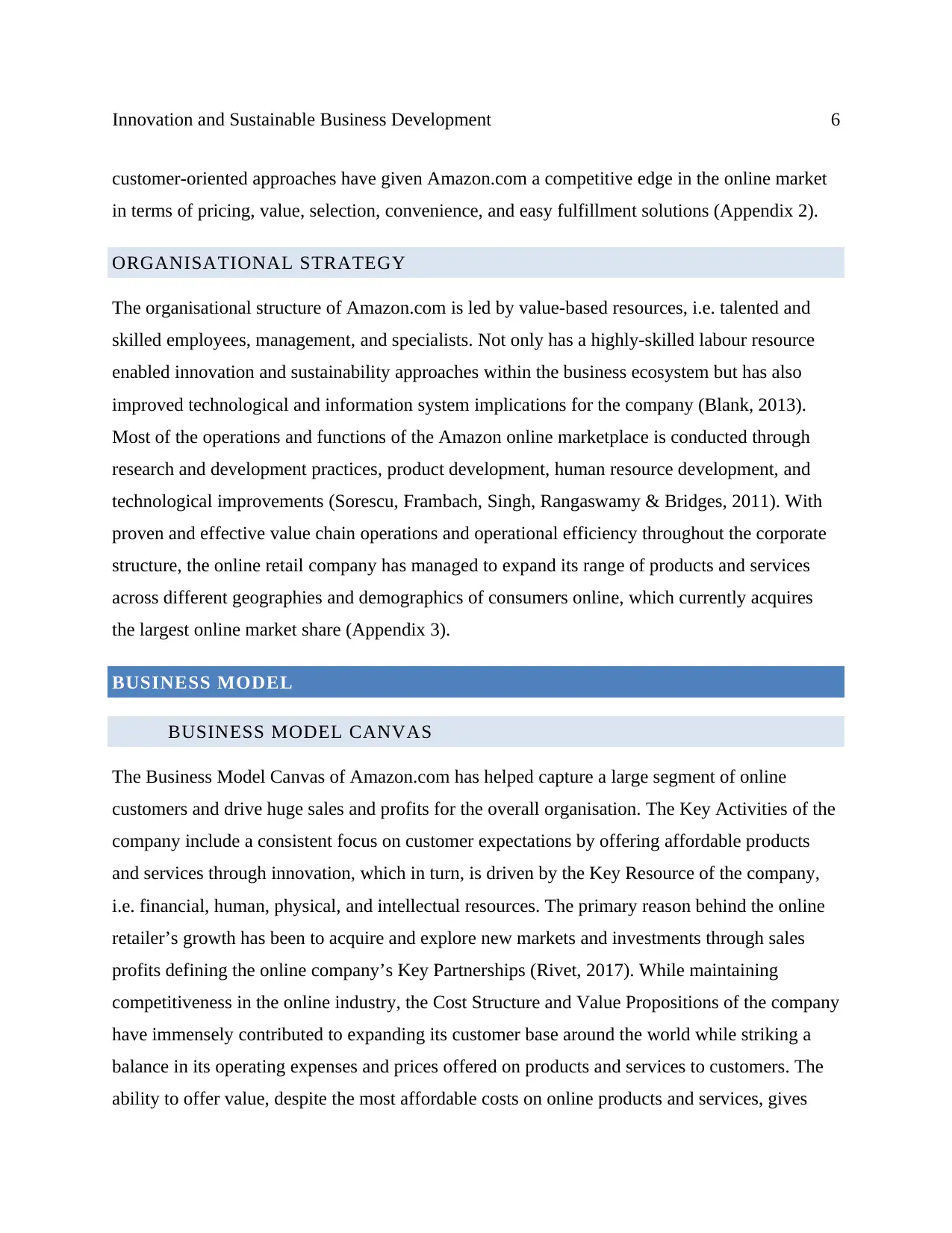
Innovation and Sustainable Business Development 6
customer-oriented approaches have given Amazon.com a competitive edge in the online market
in terms of pricing, value, selection, convenience, and easy fulfillment solutions (Appendix 2).
ORGANISATIONAL STRATEGY
The organisational structure of Amazon.com is led by value-based resources, i.e. talented and
skilled employees, management, and specialists. Not only has a highly-skilled labour resource
enabled innovation and sustainability approaches within the business ecosystem but has also
improved technological and information system implications for the company (Blank, 2013).
Most of the operations and functions of the Amazon online marketplace is conducted through
research and development practices, product development, human resource development, and
technological improvements (Sorescu, Frambach, Singh, Rangaswamy & Bridges, 2011). With
proven and effective value chain operations and operational efficiency throughout the corporate
structure, the online retail company has managed to expand its range of products and services
across different geographies and demographics of consumers online, which currently acquires
the largest online market share (Appendix 3).
BUSINESS MODEL
BUSINESS MODEL CANVAS
The Business Model Canvas of Amazon.com has helped capture a large segment of online
customers and drive huge sales and profits for the overall organisation. The Key Activities of the
company include a consistent focus on customer expectations by offering affordable products
and services through innovation, which in turn, is driven by the Key Resource of the company,
i.e. financial, human, physical, and intellectual resources. The primary reason behind the online
retailer’s growth has been to acquire and explore new markets and investments through sales
profits defining the online company’s Key Partnerships (Rivet, 2017). While maintaining
competitiveness in the online industry, the Cost Structure and Value Propositions of the company
have immensely contributed to expanding its customer base around the world while striking a
balance in its operating expenses and prices offered on products and services to customers. The
ability to offer value, despite the most affordable costs on online products and services, gives
customer-oriented approaches have given Amazon.com a competitive edge in the online market
in terms of pricing, value, selection, convenience, and easy fulfillment solutions (Appendix 2).
ORGANISATIONAL STRATEGY
The organisational structure of Amazon.com is led by value-based resources, i.e. talented and
skilled employees, management, and specialists. Not only has a highly-skilled labour resource
enabled innovation and sustainability approaches within the business ecosystem but has also
improved technological and information system implications for the company (Blank, 2013).
Most of the operations and functions of the Amazon online marketplace is conducted through
research and development practices, product development, human resource development, and
technological improvements (Sorescu, Frambach, Singh, Rangaswamy & Bridges, 2011). With
proven and effective value chain operations and operational efficiency throughout the corporate
structure, the online retail company has managed to expand its range of products and services
across different geographies and demographics of consumers online, which currently acquires
the largest online market share (Appendix 3).
BUSINESS MODEL
BUSINESS MODEL CANVAS
The Business Model Canvas of Amazon.com has helped capture a large segment of online
customers and drive huge sales and profits for the overall organisation. The Key Activities of the
company include a consistent focus on customer expectations by offering affordable products
and services through innovation, which in turn, is driven by the Key Resource of the company,
i.e. financial, human, physical, and intellectual resources. The primary reason behind the online
retailer’s growth has been to acquire and explore new markets and investments through sales
profits defining the online company’s Key Partnerships (Rivet, 2017). While maintaining
competitiveness in the online industry, the Cost Structure and Value Propositions of the company
have immensely contributed to expanding its customer base around the world while striking a
balance in its operating expenses and prices offered on products and services to customers. The
ability to offer value, despite the most affordable costs on online products and services, gives
⊘ This is a preview!⊘
Do you want full access?
Subscribe today to unlock all pages.

Trusted by 1+ million students worldwide
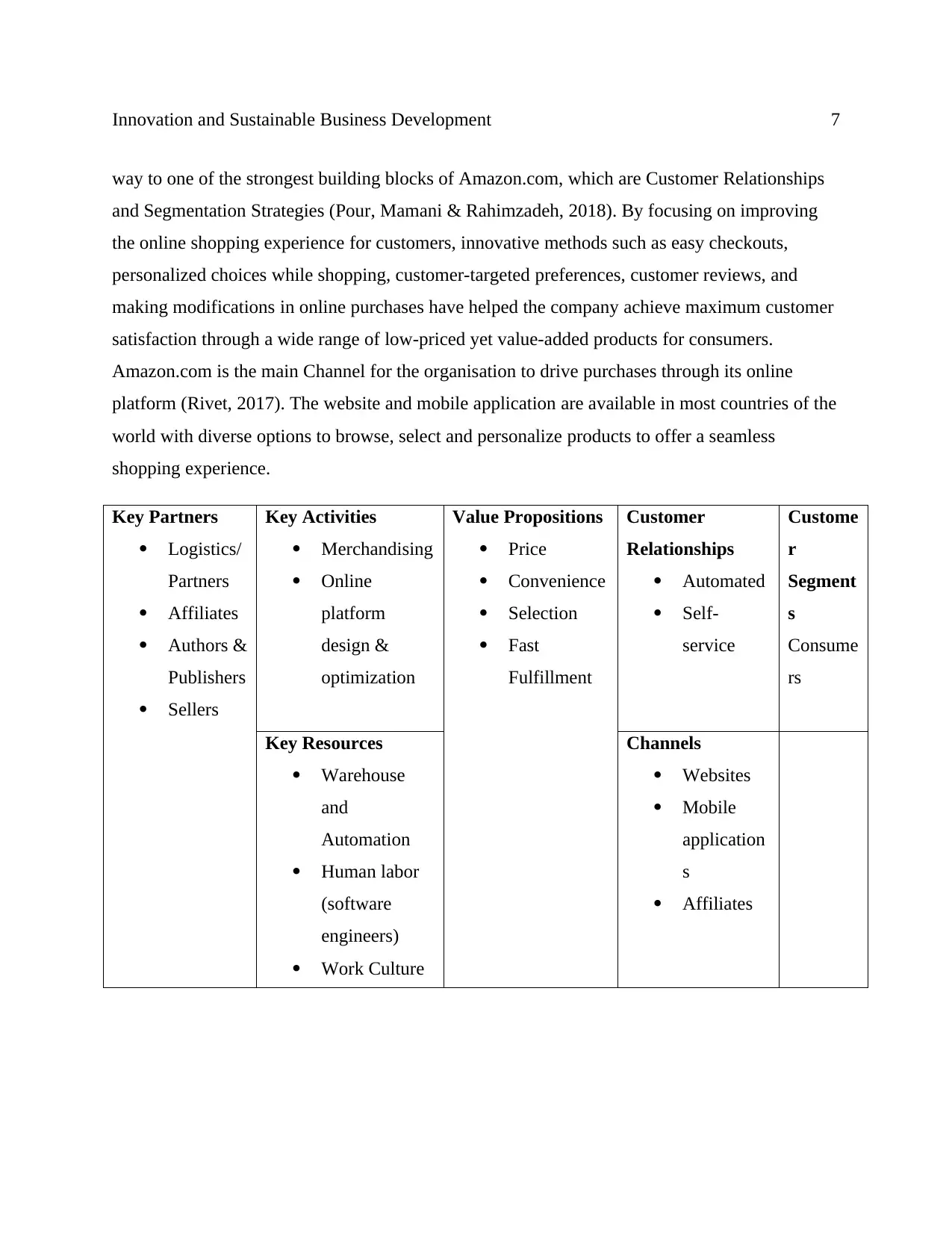
Innovation and Sustainable Business Development 7
way to one of the strongest building blocks of Amazon.com, which are Customer Relationships
and Segmentation Strategies (Pour, Mamani & Rahimzadeh, 2018). By focusing on improving
the online shopping experience for customers, innovative methods such as easy checkouts,
personalized choices while shopping, customer-targeted preferences, customer reviews, and
making modifications in online purchases have helped the company achieve maximum customer
satisfaction through a wide range of low-priced yet value-added products for consumers.
Amazon.com is the main Channel for the organisation to drive purchases through its online
platform (Rivet, 2017). The website and mobile application are available in most countries of the
world with diverse options to browse, select and personalize products to offer a seamless
shopping experience.
Key Partners
Logistics/
Partners
Affiliates
Authors &
Publishers
Sellers
Key Activities
Merchandising
Online
platform
design &
optimization
Value Propositions
Price
Convenience
Selection
Fast
Fulfillment
Customer
Relationships
Automated
Self-
service
Custome
r
Segment
s
Consume
rs
Key Resources
Warehouse
and
Automation
Human labor
(software
engineers)
Work Culture
Channels
Websites
Mobile
application
s
Affiliates
way to one of the strongest building blocks of Amazon.com, which are Customer Relationships
and Segmentation Strategies (Pour, Mamani & Rahimzadeh, 2018). By focusing on improving
the online shopping experience for customers, innovative methods such as easy checkouts,
personalized choices while shopping, customer-targeted preferences, customer reviews, and
making modifications in online purchases have helped the company achieve maximum customer
satisfaction through a wide range of low-priced yet value-added products for consumers.
Amazon.com is the main Channel for the organisation to drive purchases through its online
platform (Rivet, 2017). The website and mobile application are available in most countries of the
world with diverse options to browse, select and personalize products to offer a seamless
shopping experience.
Key Partners
Logistics/
Partners
Affiliates
Authors &
Publishers
Sellers
Key Activities
Merchandising
Online
platform
design &
optimization
Value Propositions
Price
Convenience
Selection
Fast
Fulfillment
Customer
Relationships
Automated
Self-
service
Custome
r
Segment
s
Consume
rs
Key Resources
Warehouse
and
Automation
Human labor
(software
engineers)
Work Culture
Channels
Websites
Mobile
application
s
Affiliates
Paraphrase This Document
Need a fresh take? Get an instant paraphrase of this document with our AI Paraphraser
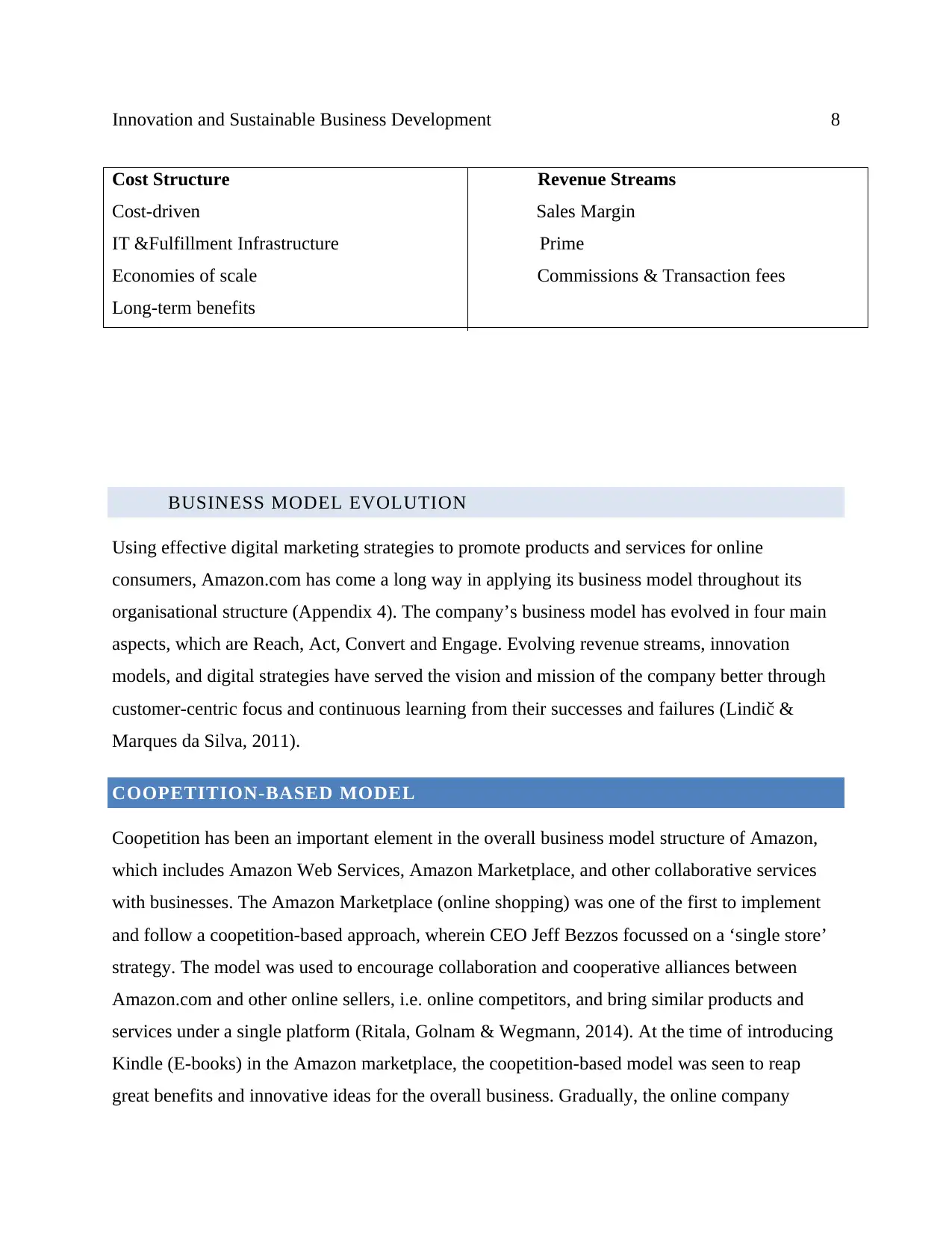
Innovation and Sustainable Business Development 8
Cost Structure Revenue Streams
Cost-driven Sales Margin
IT &Fulfillment Infrastructure Prime
Economies of scale Commissions & Transaction fees
Long-term benefits
BUSINESS MODEL EVOLUTION
Using effective digital marketing strategies to promote products and services for online
consumers, Amazon.com has come a long way in applying its business model throughout its
organisational structure (Appendix 4). The company’s business model has evolved in four main
aspects, which are Reach, Act, Convert and Engage. Evolving revenue streams, innovation
models, and digital strategies have served the vision and mission of the company better through
customer-centric focus and continuous learning from their successes and failures (Lindič &
Marques da Silva, 2011).
COOPETITION-BASED MODEL
Coopetition has been an important element in the overall business model structure of Amazon,
which includes Amazon Web Services, Amazon Marketplace, and other collaborative services
with businesses. The Amazon Marketplace (online shopping) was one of the first to implement
and follow a coopetition-based approach, wherein CEO Jeff Bezzos focussed on a ‘single store’
strategy. The model was used to encourage collaboration and cooperative alliances between
Amazon.com and other online sellers, i.e. online competitors, and bring similar products and
services under a single platform (Ritala, Golnam & Wegmann, 2014). At the time of introducing
Kindle (E-books) in the Amazon marketplace, the coopetition-based model was seen to reap
great benefits and innovative ideas for the overall business. Gradually, the online company
Cost Structure Revenue Streams
Cost-driven Sales Margin
IT &Fulfillment Infrastructure Prime
Economies of scale Commissions & Transaction fees
Long-term benefits
BUSINESS MODEL EVOLUTION
Using effective digital marketing strategies to promote products and services for online
consumers, Amazon.com has come a long way in applying its business model throughout its
organisational structure (Appendix 4). The company’s business model has evolved in four main
aspects, which are Reach, Act, Convert and Engage. Evolving revenue streams, innovation
models, and digital strategies have served the vision and mission of the company better through
customer-centric focus and continuous learning from their successes and failures (Lindič &
Marques da Silva, 2011).
COOPETITION-BASED MODEL
Coopetition has been an important element in the overall business model structure of Amazon,
which includes Amazon Web Services, Amazon Marketplace, and other collaborative services
with businesses. The Amazon Marketplace (online shopping) was one of the first to implement
and follow a coopetition-based approach, wherein CEO Jeff Bezzos focussed on a ‘single store’
strategy. The model was used to encourage collaboration and cooperative alliances between
Amazon.com and other online sellers, i.e. online competitors, and bring similar products and
services under a single platform (Ritala, Golnam & Wegmann, 2014). At the time of introducing
Kindle (E-books) in the Amazon marketplace, the coopetition-based model was seen to reap
great benefits and innovative ideas for the overall business. Gradually, the online company
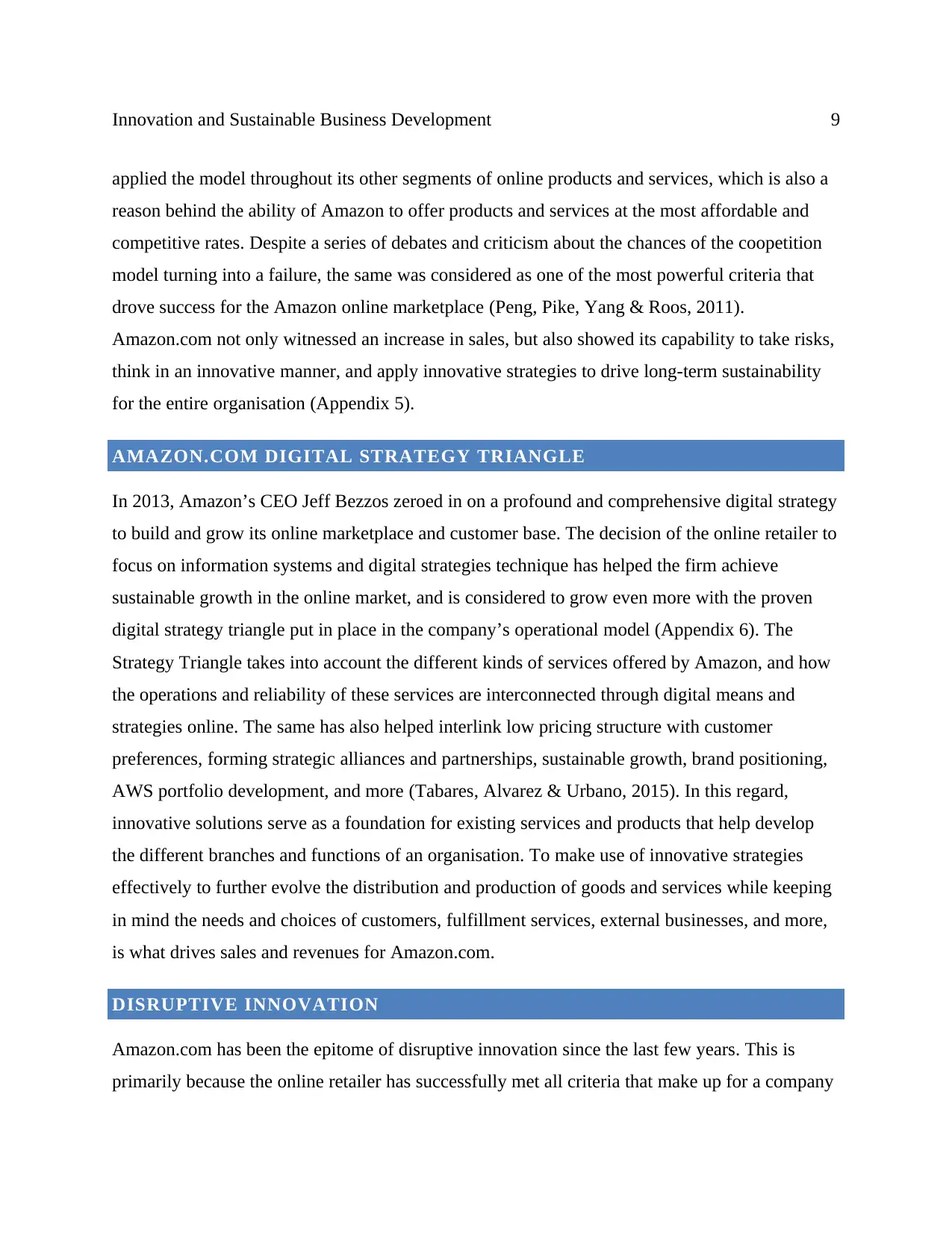
Innovation and Sustainable Business Development 9
applied the model throughout its other segments of online products and services, which is also a
reason behind the ability of Amazon to offer products and services at the most affordable and
competitive rates. Despite a series of debates and criticism about the chances of the coopetition
model turning into a failure, the same was considered as one of the most powerful criteria that
drove success for the Amazon online marketplace (Peng, Pike, Yang & Roos, 2011).
Amazon.com not only witnessed an increase in sales, but also showed its capability to take risks,
think in an innovative manner, and apply innovative strategies to drive long-term sustainability
for the entire organisation (Appendix 5).
AMAZON.COM DIGITAL STRATEGY TRIANGLE
In 2013, Amazon’s CEO Jeff Bezzos zeroed in on a profound and comprehensive digital strategy
to build and grow its online marketplace and customer base. The decision of the online retailer to
focus on information systems and digital strategies technique has helped the firm achieve
sustainable growth in the online market, and is considered to grow even more with the proven
digital strategy triangle put in place in the company’s operational model (Appendix 6). The
Strategy Triangle takes into account the different kinds of services offered by Amazon, and how
the operations and reliability of these services are interconnected through digital means and
strategies online. The same has also helped interlink low pricing structure with customer
preferences, forming strategic alliances and partnerships, sustainable growth, brand positioning,
AWS portfolio development, and more (Tabares, Alvarez & Urbano, 2015). In this regard,
innovative solutions serve as a foundation for existing services and products that help develop
the different branches and functions of an organisation. To make use of innovative strategies
effectively to further evolve the distribution and production of goods and services while keeping
in mind the needs and choices of customers, fulfillment services, external businesses, and more,
is what drives sales and revenues for Amazon.com.
DISRUPTIVE INNOVATION
Amazon.com has been the epitome of disruptive innovation since the last few years. This is
primarily because the online retailer has successfully met all criteria that make up for a company
applied the model throughout its other segments of online products and services, which is also a
reason behind the ability of Amazon to offer products and services at the most affordable and
competitive rates. Despite a series of debates and criticism about the chances of the coopetition
model turning into a failure, the same was considered as one of the most powerful criteria that
drove success for the Amazon online marketplace (Peng, Pike, Yang & Roos, 2011).
Amazon.com not only witnessed an increase in sales, but also showed its capability to take risks,
think in an innovative manner, and apply innovative strategies to drive long-term sustainability
for the entire organisation (Appendix 5).
AMAZON.COM DIGITAL STRATEGY TRIANGLE
In 2013, Amazon’s CEO Jeff Bezzos zeroed in on a profound and comprehensive digital strategy
to build and grow its online marketplace and customer base. The decision of the online retailer to
focus on information systems and digital strategies technique has helped the firm achieve
sustainable growth in the online market, and is considered to grow even more with the proven
digital strategy triangle put in place in the company’s operational model (Appendix 6). The
Strategy Triangle takes into account the different kinds of services offered by Amazon, and how
the operations and reliability of these services are interconnected through digital means and
strategies online. The same has also helped interlink low pricing structure with customer
preferences, forming strategic alliances and partnerships, sustainable growth, brand positioning,
AWS portfolio development, and more (Tabares, Alvarez & Urbano, 2015). In this regard,
innovative solutions serve as a foundation for existing services and products that help develop
the different branches and functions of an organisation. To make use of innovative strategies
effectively to further evolve the distribution and production of goods and services while keeping
in mind the needs and choices of customers, fulfillment services, external businesses, and more,
is what drives sales and revenues for Amazon.com.
DISRUPTIVE INNOVATION
Amazon.com has been the epitome of disruptive innovation since the last few years. This is
primarily because the online retailer has successfully met all criteria that make up for a company
⊘ This is a preview!⊘
Do you want full access?
Subscribe today to unlock all pages.

Trusted by 1+ million students worldwide
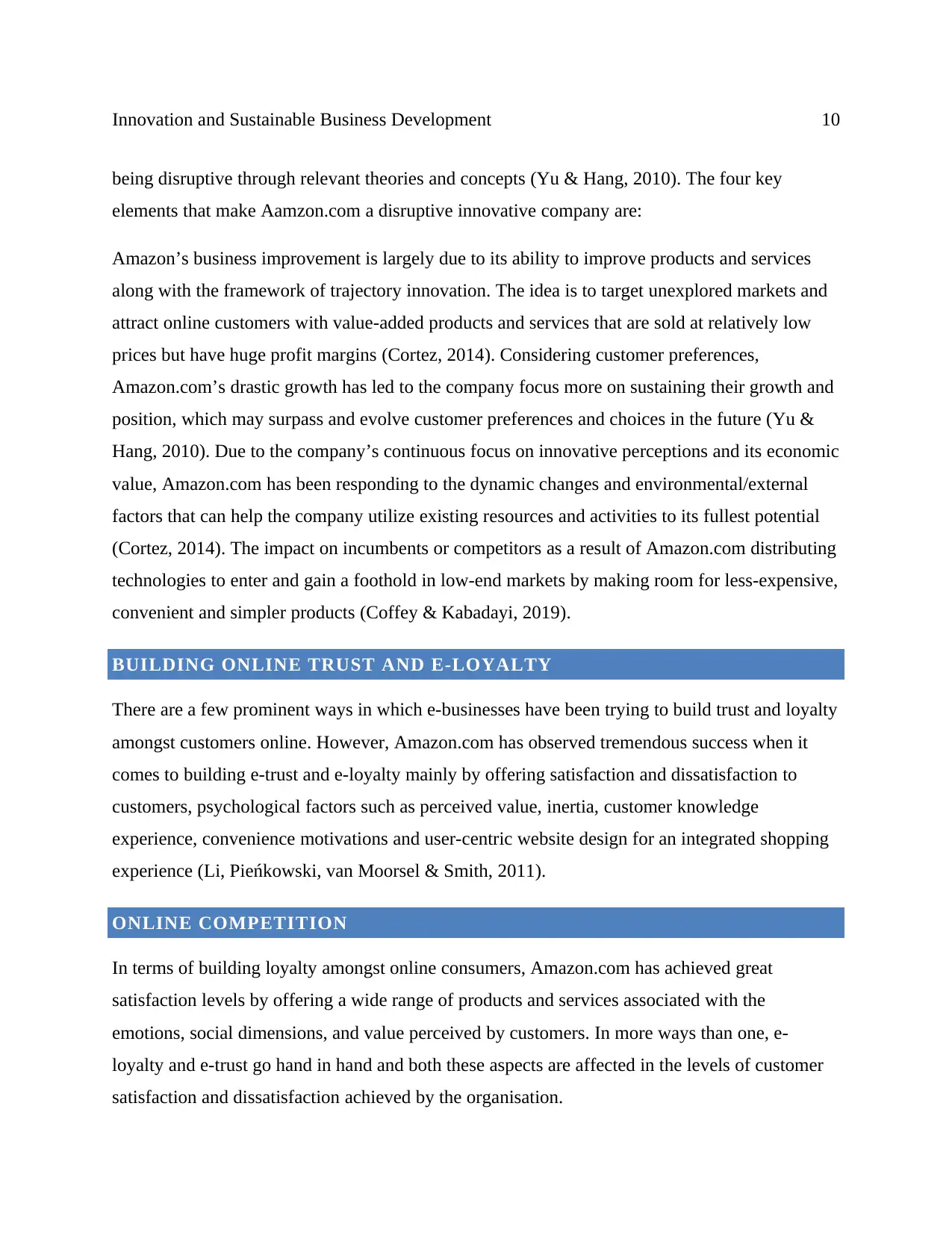
Innovation and Sustainable Business Development 10
being disruptive through relevant theories and concepts (Yu & Hang, 2010). The four key
elements that make Aamzon.com a disruptive innovative company are:
Amazon’s business improvement is largely due to its ability to improve products and services
along with the framework of trajectory innovation. The idea is to target unexplored markets and
attract online customers with value-added products and services that are sold at relatively low
prices but have huge profit margins (Cortez, 2014). Considering customer preferences,
Amazon.com’s drastic growth has led to the company focus more on sustaining their growth and
position, which may surpass and evolve customer preferences and choices in the future (Yu &
Hang, 2010). Due to the company’s continuous focus on innovative perceptions and its economic
value, Amazon.com has been responding to the dynamic changes and environmental/external
factors that can help the company utilize existing resources and activities to its fullest potential
(Cortez, 2014). The impact on incumbents or competitors as a result of Amazon.com distributing
technologies to enter and gain a foothold in low-end markets by making room for less-expensive,
convenient and simpler products (Coffey & Kabadayi, 2019).
BUILDING ONLINE TRUST AND E-LOYALTY
There are a few prominent ways in which e-businesses have been trying to build trust and loyalty
amongst customers online. However, Amazon.com has observed tremendous success when it
comes to building e-trust and e-loyalty mainly by offering satisfaction and dissatisfaction to
customers, psychological factors such as perceived value, inertia, customer knowledge
experience, convenience motivations and user-centric website design for an integrated shopping
experience (Li, Pieńkowski, van Moorsel & Smith, 2011).
ONLINE COMPETITION
In terms of building loyalty amongst online consumers, Amazon.com has achieved great
satisfaction levels by offering a wide range of products and services associated with the
emotions, social dimensions, and value perceived by customers. In more ways than one, e-
loyalty and e-trust go hand in hand and both these aspects are affected in the levels of customer
satisfaction and dissatisfaction achieved by the organisation.
being disruptive through relevant theories and concepts (Yu & Hang, 2010). The four key
elements that make Aamzon.com a disruptive innovative company are:
Amazon’s business improvement is largely due to its ability to improve products and services
along with the framework of trajectory innovation. The idea is to target unexplored markets and
attract online customers with value-added products and services that are sold at relatively low
prices but have huge profit margins (Cortez, 2014). Considering customer preferences,
Amazon.com’s drastic growth has led to the company focus more on sustaining their growth and
position, which may surpass and evolve customer preferences and choices in the future (Yu &
Hang, 2010). Due to the company’s continuous focus on innovative perceptions and its economic
value, Amazon.com has been responding to the dynamic changes and environmental/external
factors that can help the company utilize existing resources and activities to its fullest potential
(Cortez, 2014). The impact on incumbents or competitors as a result of Amazon.com distributing
technologies to enter and gain a foothold in low-end markets by making room for less-expensive,
convenient and simpler products (Coffey & Kabadayi, 2019).
BUILDING ONLINE TRUST AND E-LOYALTY
There are a few prominent ways in which e-businesses have been trying to build trust and loyalty
amongst customers online. However, Amazon.com has observed tremendous success when it
comes to building e-trust and e-loyalty mainly by offering satisfaction and dissatisfaction to
customers, psychological factors such as perceived value, inertia, customer knowledge
experience, convenience motivations and user-centric website design for an integrated shopping
experience (Li, Pieńkowski, van Moorsel & Smith, 2011).
ONLINE COMPETITION
In terms of building loyalty amongst online consumers, Amazon.com has achieved great
satisfaction levels by offering a wide range of products and services associated with the
emotions, social dimensions, and value perceived by customers. In more ways than one, e-
loyalty and e-trust go hand in hand and both these aspects are affected in the levels of customer
satisfaction and dissatisfaction achieved by the organisation.
Paraphrase This Document
Need a fresh take? Get an instant paraphrase of this document with our AI Paraphraser
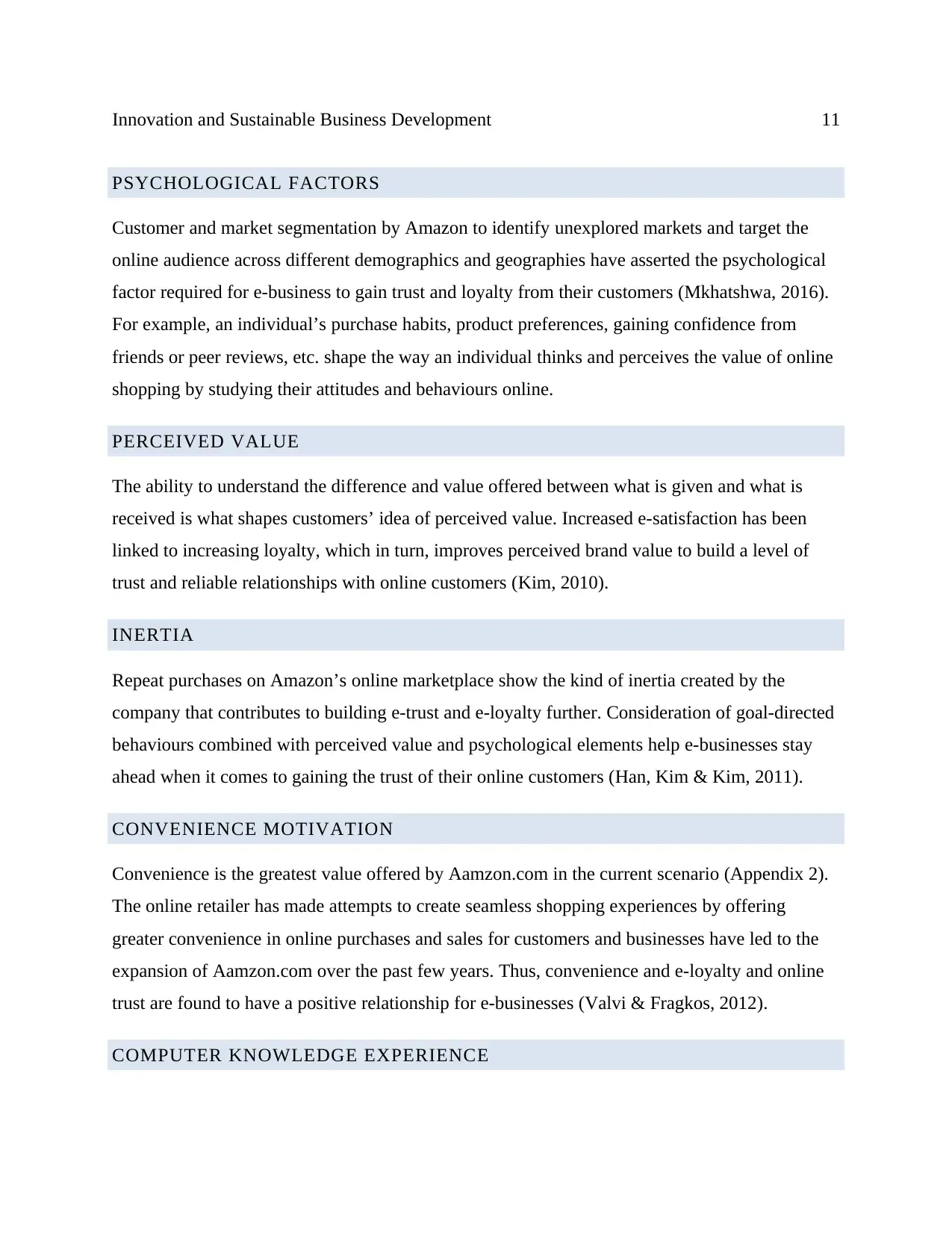
Innovation and Sustainable Business Development 11
PSYCHOLOGICAL FACTORS
Customer and market segmentation by Amazon to identify unexplored markets and target the
online audience across different demographics and geographies have asserted the psychological
factor required for e-business to gain trust and loyalty from their customers (Mkhatshwa, 2016).
For example, an individual’s purchase habits, product preferences, gaining confidence from
friends or peer reviews, etc. shape the way an individual thinks and perceives the value of online
shopping by studying their attitudes and behaviours online.
PERCEIVED VALUE
The ability to understand the difference and value offered between what is given and what is
received is what shapes customers’ idea of perceived value. Increased e-satisfaction has been
linked to increasing loyalty, which in turn, improves perceived brand value to build a level of
trust and reliable relationships with online customers (Kim, 2010).
INERTIA
Repeat purchases on Amazon’s online marketplace show the kind of inertia created by the
company that contributes to building e-trust and e-loyalty further. Consideration of goal-directed
behaviours combined with perceived value and psychological elements help e-businesses stay
ahead when it comes to gaining the trust of their online customers (Han, Kim & Kim, 2011).
CONVENIENCE MOTIVATION
Convenience is the greatest value offered by Aamzon.com in the current scenario (Appendix 2).
The online retailer has made attempts to create seamless shopping experiences by offering
greater convenience in online purchases and sales for customers and businesses have led to the
expansion of Aamzon.com over the past few years. Thus, convenience and e-loyalty and online
trust are found to have a positive relationship for e-businesses (Valvi & Fragkos, 2012).
COMPUTER KNOWLEDGE EXPERIENCE
PSYCHOLOGICAL FACTORS
Customer and market segmentation by Amazon to identify unexplored markets and target the
online audience across different demographics and geographies have asserted the psychological
factor required for e-business to gain trust and loyalty from their customers (Mkhatshwa, 2016).
For example, an individual’s purchase habits, product preferences, gaining confidence from
friends or peer reviews, etc. shape the way an individual thinks and perceives the value of online
shopping by studying their attitudes and behaviours online.
PERCEIVED VALUE
The ability to understand the difference and value offered between what is given and what is
received is what shapes customers’ idea of perceived value. Increased e-satisfaction has been
linked to increasing loyalty, which in turn, improves perceived brand value to build a level of
trust and reliable relationships with online customers (Kim, 2010).
INERTIA
Repeat purchases on Amazon’s online marketplace show the kind of inertia created by the
company that contributes to building e-trust and e-loyalty further. Consideration of goal-directed
behaviours combined with perceived value and psychological elements help e-businesses stay
ahead when it comes to gaining the trust of their online customers (Han, Kim & Kim, 2011).
CONVENIENCE MOTIVATION
Convenience is the greatest value offered by Aamzon.com in the current scenario (Appendix 2).
The online retailer has made attempts to create seamless shopping experiences by offering
greater convenience in online purchases and sales for customers and businesses have led to the
expansion of Aamzon.com over the past few years. Thus, convenience and e-loyalty and online
trust are found to have a positive relationship for e-businesses (Valvi & Fragkos, 2012).
COMPUTER KNOWLEDGE EXPERIENCE
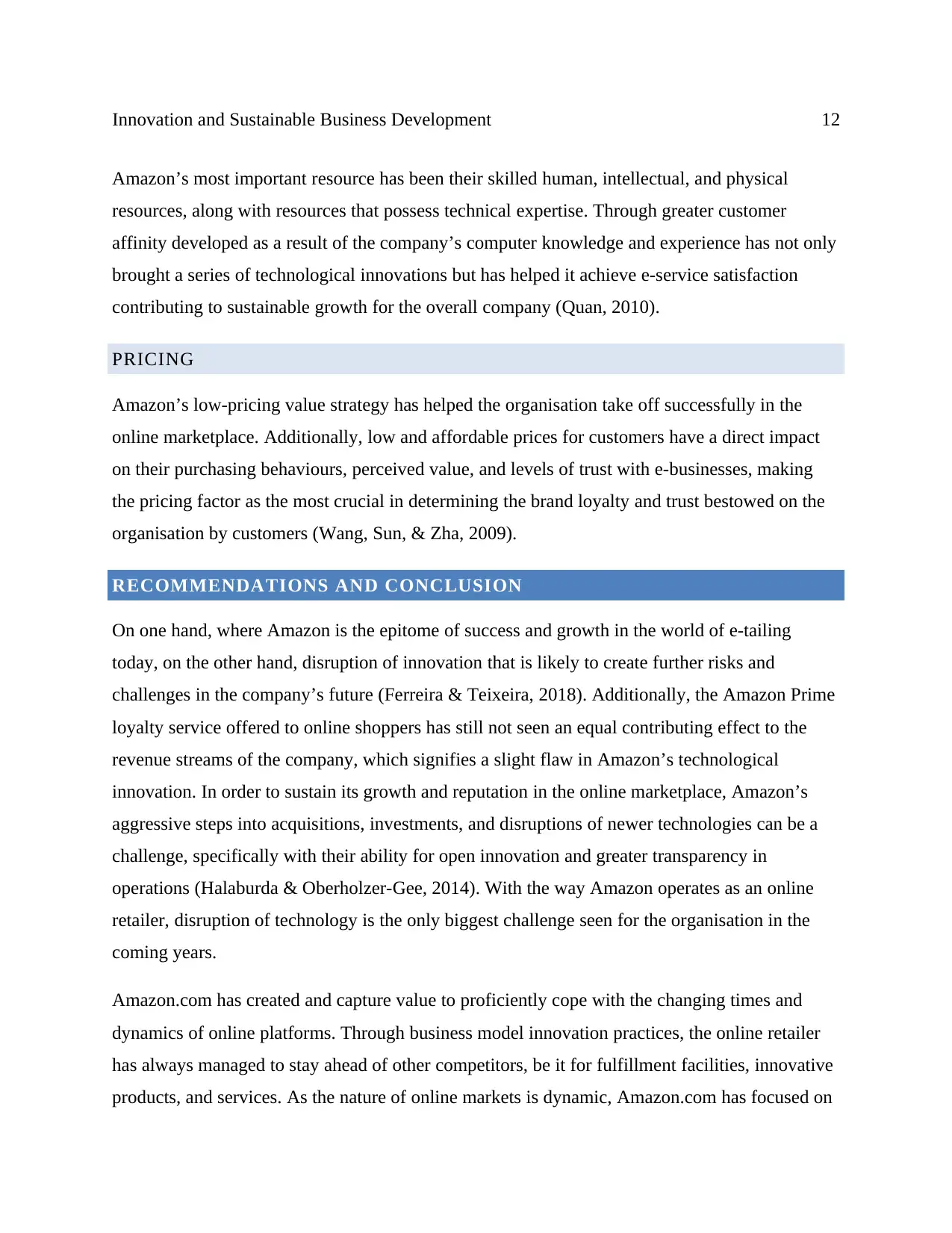
Innovation and Sustainable Business Development 12
Amazon’s most important resource has been their skilled human, intellectual, and physical
resources, along with resources that possess technical expertise. Through greater customer
affinity developed as a result of the company’s computer knowledge and experience has not only
brought a series of technological innovations but has helped it achieve e-service satisfaction
contributing to sustainable growth for the overall company (Quan, 2010).
PRICING
Amazon’s low-pricing value strategy has helped the organisation take off successfully in the
online marketplace. Additionally, low and affordable prices for customers have a direct impact
on their purchasing behaviours, perceived value, and levels of trust with e-businesses, making
the pricing factor as the most crucial in determining the brand loyalty and trust bestowed on the
organisation by customers (Wang, Sun, & Zha, 2009).
RECOMMENDATIONS AND CONCLUSION
On one hand, where Amazon is the epitome of success and growth in the world of e-tailing
today, on the other hand, disruption of innovation that is likely to create further risks and
challenges in the company’s future (Ferreira & Teixeira, 2018). Additionally, the Amazon Prime
loyalty service offered to online shoppers has still not seen an equal contributing effect to the
revenue streams of the company, which signifies a slight flaw in Amazon’s technological
innovation. In order to sustain its growth and reputation in the online marketplace, Amazon’s
aggressive steps into acquisitions, investments, and disruptions of newer technologies can be a
challenge, specifically with their ability for open innovation and greater transparency in
operations (Halaburda & Oberholzer-Gee, 2014). With the way Amazon operates as an online
retailer, disruption of technology is the only biggest challenge seen for the organisation in the
coming years.
Amazon.com has created and capture value to proficiently cope with the changing times and
dynamics of online platforms. Through business model innovation practices, the online retailer
has always managed to stay ahead of other competitors, be it for fulfillment facilities, innovative
products, and services. As the nature of online markets is dynamic, Amazon.com has focused on
Amazon’s most important resource has been their skilled human, intellectual, and physical
resources, along with resources that possess technical expertise. Through greater customer
affinity developed as a result of the company’s computer knowledge and experience has not only
brought a series of technological innovations but has helped it achieve e-service satisfaction
contributing to sustainable growth for the overall company (Quan, 2010).
PRICING
Amazon’s low-pricing value strategy has helped the organisation take off successfully in the
online marketplace. Additionally, low and affordable prices for customers have a direct impact
on their purchasing behaviours, perceived value, and levels of trust with e-businesses, making
the pricing factor as the most crucial in determining the brand loyalty and trust bestowed on the
organisation by customers (Wang, Sun, & Zha, 2009).
RECOMMENDATIONS AND CONCLUSION
On one hand, where Amazon is the epitome of success and growth in the world of e-tailing
today, on the other hand, disruption of innovation that is likely to create further risks and
challenges in the company’s future (Ferreira & Teixeira, 2018). Additionally, the Amazon Prime
loyalty service offered to online shoppers has still not seen an equal contributing effect to the
revenue streams of the company, which signifies a slight flaw in Amazon’s technological
innovation. In order to sustain its growth and reputation in the online marketplace, Amazon’s
aggressive steps into acquisitions, investments, and disruptions of newer technologies can be a
challenge, specifically with their ability for open innovation and greater transparency in
operations (Halaburda & Oberholzer-Gee, 2014). With the way Amazon operates as an online
retailer, disruption of technology is the only biggest challenge seen for the organisation in the
coming years.
Amazon.com has created and capture value to proficiently cope with the changing times and
dynamics of online platforms. Through business model innovation practices, the online retailer
has always managed to stay ahead of other competitors, be it for fulfillment facilities, innovative
products, and services. As the nature of online markets is dynamic, Amazon.com has focused on
⊘ This is a preview!⊘
Do you want full access?
Subscribe today to unlock all pages.

Trusted by 1+ million students worldwide
1 out of 22
Related Documents
Your All-in-One AI-Powered Toolkit for Academic Success.
+13062052269
info@desklib.com
Available 24*7 on WhatsApp / Email
![[object Object]](/_next/static/media/star-bottom.7253800d.svg)
Unlock your academic potential
Copyright © 2020–2025 A2Z Services. All Rights Reserved. Developed and managed by ZUCOL.




